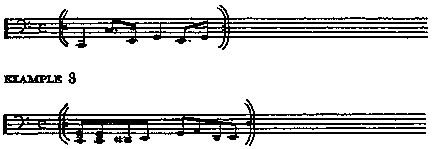The Book Of Jazz - online reference book
Its Nature, Instruments, Sources, Sounds, Development & Performers
| Share page | Visit Us On FB |
|
The Piano |
6$ |
||
|
|
|||
|
right to know; Marlowe Morris (today a Hammond organist); Sir Charles Thompson (with the first big Hampton band in 1940) and the Napoleon brothers, Marty and Teddy, both engaged in their first name-band forays in the early '40s.
Practically simultaneous with the discovery and development of the Wilson school was the emergence of boogie-woogie, a piano form that enjoyed a forest-fire burst of exposure during a five-year stretch (1936-41) before leveling off into comparative obscurity. Originally known among Negro musicians simply as "walking bass", boogie-woogie was a piano style characterized not by the use of eight beats to the bar (though the majority of its exponents used this rhythm almost constantly in the bass) but by the employment, in the left hand, of any repeated rhythm that makes any use at all of eighth notes. (Ex. 2, which clearly is not "eight-to-the-bar", is none the less one of the most famous of the boogie-woogie rhythms, used in Yancey Special and others, while Ex. 3 offers a more typical sample of the kind of repeated bass "rifF usually associated with boogie-woogie.)
example 2 |
|||
|
|
|||
 |
|||
|
The white public remained completely unaware of boogie-woogie for many years, though there is evidence that the use of similar figures, on piano or guitar, goes back as far as 1912. The earliest and best of the pianists were Jimmy Yancey, who though immortalized in others' versions of Yancey Special did not himself record until 1939; Cow Cow Davenport, who toured as a vaudevillian from 1914 until 1930; and Clarence "Pinetop" Smith, who fortunately recorded two sessions shortly before his |
|||